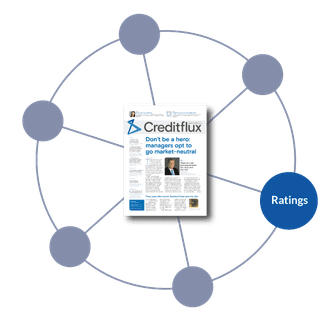

January 2022 | Issue 241
Analysis
Technical
A fresh approach to loss distribution
Jack Xu
Founder of Modtris Financial Modelling
jackxu@modtris.com
Considering how cash balances change over time, loss distribution models can look very
different to conventional thinking. So is your CLO’s pricing based on incorrect assumptions?
The risk of principal loss on a CLO tranche is the cumulative distribution of aggregated asset loss above the subordination level of the tranche. As the asset principal is partitioned into different tranches, the shape of the loss distribution function is the critical determinant of relative risk, and hence price, of the CLO tranches.
To derive the loss distribution function, three pieces of information are generally required: the default probability of each loan issuer, the recovery rate upon each default and the default correlation among all the issuers. Historically, these three types of value are derived separately, although in real life they should be closely connected as they are all driven by the same force that causes a company to default.
The reason for this lack of connection is because the current way of modelling corporate default, using probability established from either credit ratings or alternative metrics (KMV, Altman, etc), does not model how a company defaults.

Source: Modtris and Credit Rubric
How companies actually default
In reality, a company defaults because it runs out of cash. Unfortunately, modelling the change in a company’s cash balance is much more complicated than it may seem. This is because almost every financial item — inventory, fixed asset, investment, receivable, debt, payable, equity capital etc — interacts with the level of cash. In essence, modelling cash requires modelling a company’s entire balance sheet in its full dimensionality. Such a direct approach has not been explored to forecast default. However, my research has recently made breakthroughs along this direction.
My methodology breaks down the complexity of a company’s financial state by a set of operators (called actions) that replicate the fundamental financing and operational actions of a company. In a way, the fundamental actions play the role of partial differential equations in a dynamical system.
The actions are calibrated to a company’s full historical financial statements to establish the correct initial state of the company. The iteration of actions over time generates a company’s future financial states from its initial state. Unlike metric-based probability methods, the dynamical approach establishes the explicit path along which a company heads into default, thus integrating the forecast of default, recovery rate and the correlation of default under one single consistent algorithm.
Source: Modtris and Credit Rubric
We applied the method to eight actual companies provided by Creditflux and using data from Credit Rubric. All were downgraded to triple C during 2020, and are still held by European CLOs. We use eight years of historical company financials as model inputs and simulated the future paths of operating actions, such as capacity utilisation, sales ratio and sales margin as random variables based on calibrated historical values. For the future values of actions associated with company planning (corporate real options), such as the level of new debt, level of capital expenditure, and pay-down rate of payables, a child-simulation performs a five-year forward-scenario analysis (based on the realised operating values) at each time step. This selects the values that reduce most of the risk of default and achieve most of a given growth target.
There are also random macro-constraints based on historical market data that impose limits on the growth rate of total debt, payables or sales etc. Along each simulated path, the model actions generate every incremental change of a company’s balance sheet within each time-step and the associated income item. If cash becomes negative, a company is declared to have defaulted.
Importantly, the eight companies are simulated simultaneously along each path, so all companies are subject to the same macro-constraints and their operating actions are correlated based on historical values.
“This establishes the path along which a company heads into default”
Using 300 simulated paths, we derived the annual default probabilities and recovery rates (separately for senior secured debt and unsecured debt) over a 12-year forward horizon. The results imply fairly high 10-year cumulative default rates, ranging 75%-100%, among the eight companies. In comparison, the historical 10-year default rate for all Caa/C rated corporate bonds is 74%1. The principal recovery rates of senior secured debt are mostly above 60% and as high as 100% (ignoring recovery delay), while unsecured debt gets zero recovery for all but one company2. The expected principal loss over time approaches 37% for the majority of secured debt but 100% for most unsecured debt.
Figure 1 shows, for one of the eight companies, the derived annual default probabilities and the average recovery rates. The front-loaded pattern of the default curve is typical among the portfolio companies. In this case, 49% default probability in year one, after which, if the company survives, the default risk falls significantly and varies between 0-20%. The recovery rates of senior secured debt varies between 60% and 100%.
From these results, one can derive that the cumulative default probability is 49% by year one, 67% by year five, and 75% by year 10. The expected principal loss on the senior secured debt would be 17% by year one and 23% by year five and thereafter.
Source: Modtris and Credit Rubric
Default clustering is prevalent
Figure 2 shows the default timing of the eight companies from 11 out of 300 simulated paths. To derive aggregate loss, we assume a portfolio of secured debt equally weighted in the eight companies. For the purpose of illustration, we assume the portfolio has a 10-year tenor with constant principal balance (ie, for a company not in default, always replace matured debt with new debt). Figure 3 shows the distribution function on aggregate principal loss over one, five and 10-year periods. The loss distribution for year one peaks at a relatively high 25% aggregate loss, with a small but positive likelihood of no loss. The most likely level of aggregate loss increases only slightly above 25% over the years, although the peak likelihood itself does increase significantly from year one to year five. At all times, the distribution falls quickly to zero for any aggregate loss greater than 30%.
Source: Modtris and Credit Rubric
To compare our results with a rating-based method, we assume for all eight companies an annual default probability curve of 21% in year one, 15% in year two and three, 13% in year four, 11% in year five, and 10% in year six and after, as suggested by the historical default rates of all Caa/C companies1. We assume exogenously a 70% recovery rate on secured debt for six of the eight companies and 100% for two of the eight companies.
We use eight standard normal distributions to simulate default and assume a 25% pair-wise correlation of the eight distributions. Figure 4 shows the loss distribution function for the same portfolio of senior secured debt, also simulated in 300 paths.
The result shows a different pattern of the distribution function over time: in year one, the peak distribution is at a much lower loss level than projected by the dynamical model. Furthermore, the most likely loss level moves significantly higher over time. Had we assumed 70% annual default probability in year one while keeping the other years unchanged, the loss distribution functions over time would become closer to one another but the overall pattern would still be significantly different from what is derived by the dynamical model. Therefore, the loss distribution functions derived by the dynamic model and the conventional probability method can lead to significantly different CLO tranche prices.
More accurate CLO pricing
Directly modelling the cause of default through balance sheet dynamics can derive default risk, recovery rate and default correlation within a single consistent algorithm. The result can potentially lead to loss distribution functions more closely connected to company fundamentals and hence more accurate pricings of CLO tranches.
1 Measuring Corporate Default Rate, 2006. Moody’s Investor Service
2 The recovery rates are derived from the balance sheet at the time of default and under assumed liquidation values of each asset type (50% on inventory, 50% on fixed asset, 20% on goodwill etc). They are also based on the recovery ranking of liabilities (secured debt ranks before payables while unsecured debt ranks after).
Share this article:
Global credit funds & CLO's
January 2022 | Issue 241
Published in London & New York.
Copyright Creditflux. All rights reserved. Check our Privacy Policy and our Terms of Use.
























